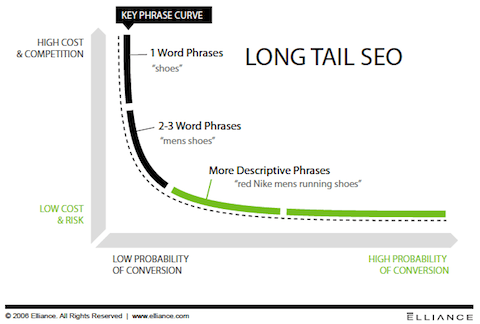
There is no doubt that SEO has changed a lot over the last 12 months. I remember the days when SEOs, including me, focused our time and energy on boosting our rankings. We would track all of our keywords and watch them go up as we built links.
And although some SEOs still do this, I myself haven’t tracked my rankings in over a year.
Why? Because SEO has turned into a long tail game.
But before I get into how you can build up your long tail traffic, here is why you should focus your SEO efforts on the long tail:
Why the long tail?
In the last 30 days Quick Sprout got 88,833 visitors from search engines. Out of those 88,333 visitors, 80383 came from long tail searches.And it’s not just Quick Sprout, a lot of businesses are experiencing this as well. KISSmetrics received 156,482 visitors from search engines in the last 30 days and out of those visitors 142,493 came from long tail keywords. And when you look at conversions from search, long tail keywords account for 87% of the conversions.

Plus, if you look at the image above you’ll notice that 1 or 2 word key phrases are costly to rank for and they don’t convert well. Searchers are also getting more sophisticated and are starting to use more words in their searches, which is why head term searches are down by 8%.
Now that you know why long tail SEO is where you should focus your efforts, here is how you build up your long tail traffic:
Infographics
The strategy we used to kick off our long tail SEO efforts for KISSmetrics was through infographics. Within 2 years we were able to generate 2,512,596 visitors, and 41,142 backlinks from 3741 unique domains all from those 47 infographics.And do you know how much we spent to do all of that? Only $28,200.
Although infographics are visual, we typically added a paragraph of text on each one, which help boosted the amount of long tail traffic we got. Plus all of those internal links helped our blog posts rank well, which caused more long tail traffic.
If you want to create infographics, there are a few things you need to know:
- The topic has to be unique – the topic of your infographic has to be original because infographics aren’t new and cool anymore. If you regurgitate old information in an infographic, it’s won’t be too successful.
- Pick a topic that benefits your readers – don’t try to create infographics for the sake of creating them. They have to benefit your readers by providing them with tangible advice. For example, our infographic on how colors affect purchases got over 5000 tweets, while our infographic on which US brands spend the most on advertising only got 259 tweets. Why because the post on colors teaches people something that they can use on their on website. The post on advertising doesn’t teach anyone anything that they can use for their own website.
- Always use stats– the more stats you use the better
off you are. Just make sure you don’t use so many that the infographic
becomes too long. Ideally there should only be 5 to 7 main points in
your graphic. For example, the how colors affect purchases infographic
has 6 points:
- How color affects marketing
- How color affects branding
- The meanings of each color to consumers
- How design affects purchases
- How time affects purchases
- How words affect conversions
- Make it pretty – infographics are so common now, that they really need to be pretty. If you don’t have a great designer, they won’t do to well.
Writing great content
The easiest way to boost your long tail traffic is through content. But you can’t just write any form of content, your blog posts have to be very detailed. And once you have good content, you have to promote it through the social web.If you want to learn how to write really detailed blog posts that are good, read this post. And if you want to learn how to promote your content, read this post.
The one thing I’ve learned about content marketing is that detailed guides tend to do the best. I know SEOmoz once stated that their Beginner’s Guide to SEO has gotten over a million visits.
At KISSmetrics we’ve published 480 blog posts, in which 34 of them are marketing guides. And although marketing guides only make up 7% of our content, it is actually responsible for 38% of our search traffic. That’s huge! It shows that writing in depth content on niche topics provides a better ROI than just writing short blog posts.
Guest post
I did a test with Quick Sprout last year in which I guest posted all over the web for 6 months. During that time period I wrote 59 guest posts on sites that had at least a Google PageRank of 4 and had an Alexa rating under 50,000.Some examples of posts I wrote are:
- The 10 Golden Rules to Attracting Authority Links
- How You Can Rank a New Site Higher Than an Old Site
- Your “How-To” Post Will Fail If You Don’t Use These Techniques
- How to Create Smarter Content Using Semantic Keyword Research

Now I know that there were other external effects that could have caused those 30 internal pages to receive more traffic such as search engine algorithm updates, but the other internal pages only saw a 38% increase in search traffic during that same time period, while the internal pages that I built 117 links to saw a 148% increase in search traffic.
Conclusion
If you want to go after head terms, by all mean do so. But if you want to try something new, stop checking your rankings, create good content and build authority links to your internal pages. In the long run your SEO traffic will go up.What I track these days is my overall search traffic and if it is going up month over month.
No comments:
Post a Comment
Thanks For you Comment As soon as possible i will reply you.